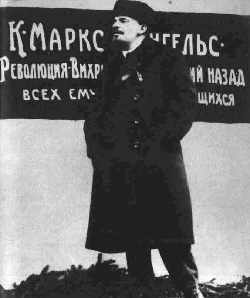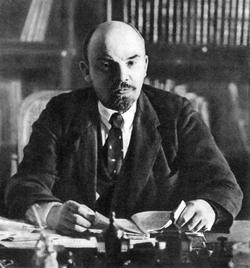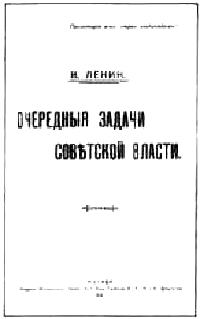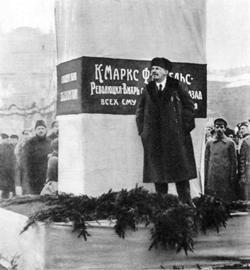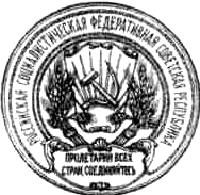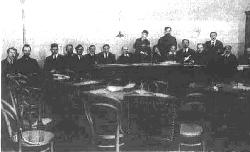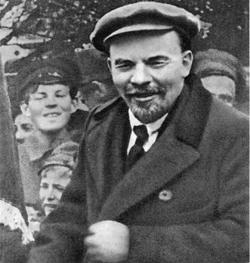V.I.Lenin - Founder of the Soviet State
(October 1917-1918)
Lenin speaks at the unveiling ot a temporary monument to Karl Marx and Frederick Engels. 1918.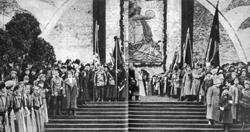
Lenin in Red Square at the celebration of the first anniversary of the Great October Socialist Revolution. 1918
Lenin with his sister Maria llyinichna Ulyanova and his wife Nadezhda Konstantinovna Krupskaya in Red Square. 1919.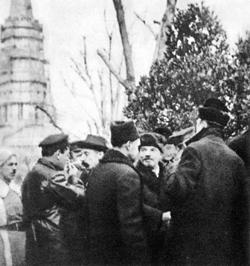
Lenin with a group of comrades in Red Square. Moscow, 1918.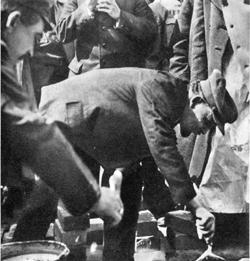
Lenin lays the foundation stone of Marx's monument. 1920.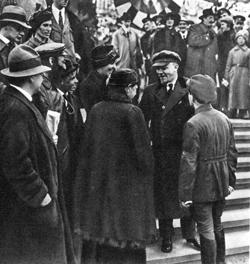
Lenin and Krupskaya with a group of comrades. 1919.The exhibition in the hall opens with the words of V.I.Lenin: "Soviet power is the road to socialism that was discovered by the masses of the working people, and that is why it is the true road, that is why it is invincible." (to heard Lenin speeches visit Lenin Famous speaches at the Defend Lenin mausoleum! site). The October Socialist Revolution elevated the vast masses of people to the level of political life. New tasks faced the Party: the formation and consolidation of the Soviet Government, the reconstruction of society along socialist lines. 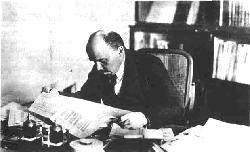
Lenin in his Kremlin office. 1918To the left of the entrance are the decrees of the Soviet Government liquidating the organs of bourgeois power and forming new Soviet governmental apparatus, and the "Declaration of Rights of the Toiling and Exploited People" which formed the basis of the Soviet Constitution. The draft Constitution was also drawn up by V. I. Lenin. On the display stand in the hall are Lenin's words: "No revolution is worth anything unless it can defend itself." On exhibit is the Decree of the Soviet Government of January 15 (28), 1918 on the organisation of the Red Army of Workers and Peasants, and a photograph of volunteer registrations for the Red Army. 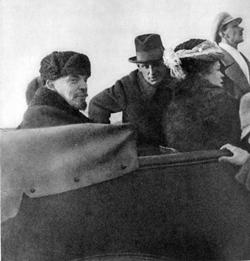
Vladimir Lenin and Maria llyinichna Ulyanova. May 1, 1918.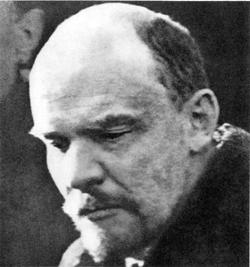
Lenin at the funeral of M. T. Yelizarov, the husband of his sister Anna. 1919.An entire group of documents relate the struggle of the Bolshevik Party and V. I. Lenin for withdrawal from the imperialist war. The so-called "left Communists", the Socialist-Revolutionaries and the Menusheviks took a stand against concluding the war in those days. They alleged that continuation of the war against Germany would become a stimulus for revolution in the West. But it was clear to Lenin that this adventurist tactic would lead to the loss of Soviet power. In his articles, "The Revolutionary Phrase" and "Strange and Monstrous", written in February 1918, during the days of sharp struggle within the Party on the question of signing the difficult, predatory conditions of peace dictated by Germany, V.I.Lenin demonstrated that the only correct decision in the given circumstances was the conclusion of peace on any terms. "These terms must be signed," he said. "If you don't sign them, you will sign the Soviet power's death warrant..."
Lenin's work "The Immediate Tasks of the Soviet Government"Soviet Russia received a necessary respite of peace, thus concluding in March 1918 this unfortunate, in Lenin's words, peace treaty. During this period V.I.Lenin and the Party consolidated forces in solving the task of socialist construction. The central exhibit in this exposition is Lenin's work, "The Immediate Tasks of the Soviet Government", in which he contemplates the plan for the socialist construction, elucidates the most important problems of the transition period from capitalism to socialism, and works out the bases for the Soviet Government's economic policy. Many of the fundamental ideas formulated by Lenin in this work are greatly significant up to this day under the conditions of developed socialist society and the all-out construction of communism. In special display in the hall Lenin's words are cited, "We, the Bolshevik Party, have convinced Russia. We have won Russia from the rich for the poor, from the exploiters for the working people. Now we must administer Russia."
Lenin speaks at the unveiling ot a temporary monument to Karl Marx and Frederick Engels. 1918.V.I.Lenin assigned an important role to the achievement of high productivity of labour, the realisation of the scientific and technological revolution, socialist emulation which became an important method for the construction of a communist society, and the development of creative initiative among the masses. The exhibit items in this hall recount the Party measures in the area of cultural development introduced on the initiative of V.I. Lenin. Among them are the draft of his speech at the First All-Russia Congress on Education, decrees on the wiping out of illiteracy in the country and on opening schools for working people....
On the pier between the windows hang the Soviet State Emblem and first Constitution-the basic code of law of the Russian Socialist Federative Soviet Republic adopted by the Fifth All-Russia Congress of Soviets in July 1918. The great achievements of the October Socialist Revolution which secured for all workers in Russia participation in governing the State were enshrined in the Constitution. "The world has never known such a constitution as ours," said Lenin. "It embodies the worker experience of struggle and organisation against the exploiters both at home and abroad." Shortly before the October Revolution a Russian bourgeois-monarchist newspaper New Times wrote: "Allow us to think for a moment, that the Bolsheviks are victorious. Who will govern us then? Perhaps cooks, the experts in cutlets and steaks? Or firemen? Stable-men, stokers? Or perhaps nannies will run to the meeting of the Council of State between diaper washings? Who, then? Who are these statesmen? Perhaps the locksmiths will take care of the theatres, the plumbers will look after diplomacy and the carpenters will be in charge of the post and telegraph?... Shall It be like this? No; Is this possible? History shall answer the Bolsheviks on their crazy question." History did answer in the first months of Soviet power's existence-the working people proved able to solve the most complicated unprecedented problems in socialist government, to direct the economy and form a new culture. The respite gained as a result of concluding the Brest Peace Treaty proved to be a short one. Foreign imperialism and internal counter-revolution could not reconcile themselves to the victory of the workers and peasants in Russia. In the spring of 1918 American, English and French troops captured Murmansk. Japanese, English and then American soldiers landed in Vladivostok. Thus imperialists of various countries began an armed intervention against the Soviet country, uniting with internal counter-revolutionary forces. A civil war broke out in Russia. The enemies used every possible means in their struggle against Soviet power. They began a conspiracy whose goal was the overthrow of the Soviet Government and the assassination of the leader of the revolution. On August 30, 1918, the Socialist-Revolutionary Kaplan made an attempt on Lenin's life and seriously wounded him with poisoned bullets. Vladimir llyich's life was critically endangered. Letters and telegrams to Lenin from workers, peasants, civil servants and the Red Army soldiers are on exhibit in the display cases of this hall. They wish their beloved leader the speediest recovery. The clothes Lenin wore on the day he was wounded are now displayed here.
The first Soviet governmentOn September 16, Lenin returned to work. A photograph of him after his recovery can be seen in this exhibit. He is photographed with Administrative Manager of the Council of People's Commissars, V. D. Bonch-Bruyevich (see Bonch-Bruevich article on Lenin at the Defend Lenin mausoleum! site) during a walk in the Kremlin courtyard. There is also a photo of his room in Gorki (outside of Moscow), where Lenin lived and worked in the fall of 1918. Here he wrote a large part of his book The Proletarian Revolution and the Renegade Kautsky. Several pages of the manuscript of this book are located in this exposition. In his book V. I. Lenin revealed the opportunism of K. Kautsky, one of the leaders of the Second International, exposed him as a falsifier of Marxism, who had shifted to the service of the bourgeoisie. In this work he thoroughly analyses the content of the proletarian revolution in Russia which gave all the working people of Russia true democracy and freedom. "Soviet power," wrote V.I.Lenin, "is a million times more democratic than the most democratic bourgeois republic."
Lenin in a car in Red Square. May 1,1919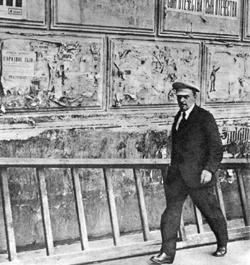
Lenin on his way to the Bolshoi Theatre where the Fifth All-Russia Congress of Soviets was held. 1918.Organisation of the country's defence (1918-1920) |
